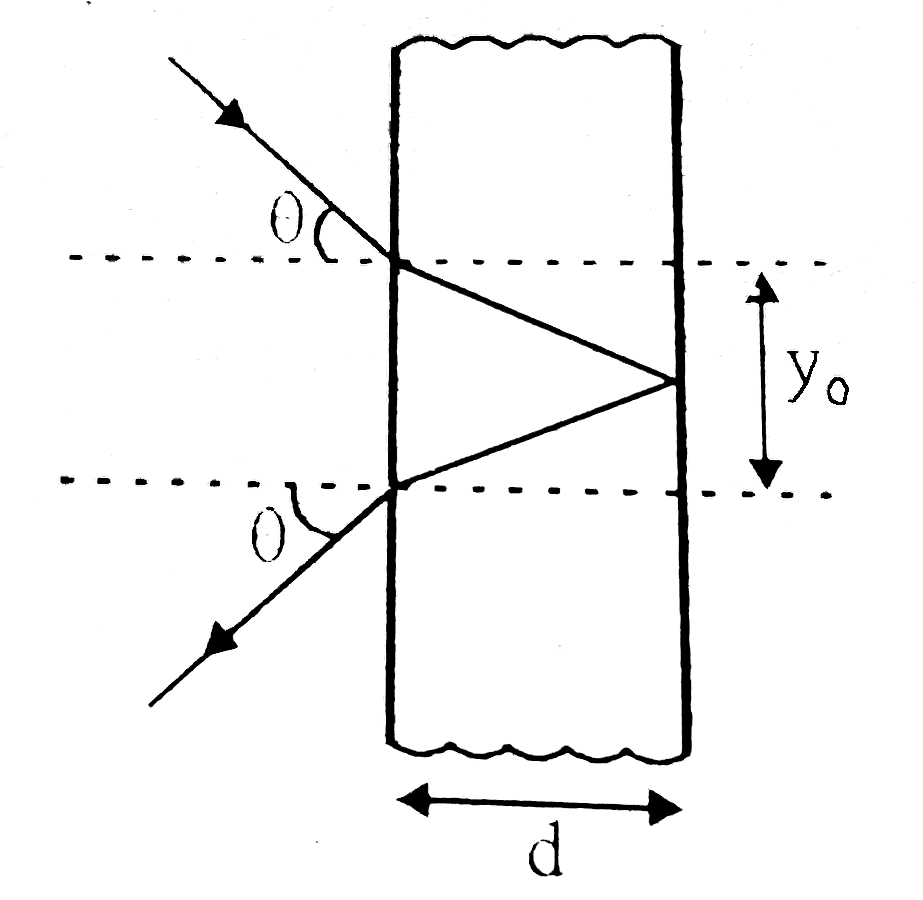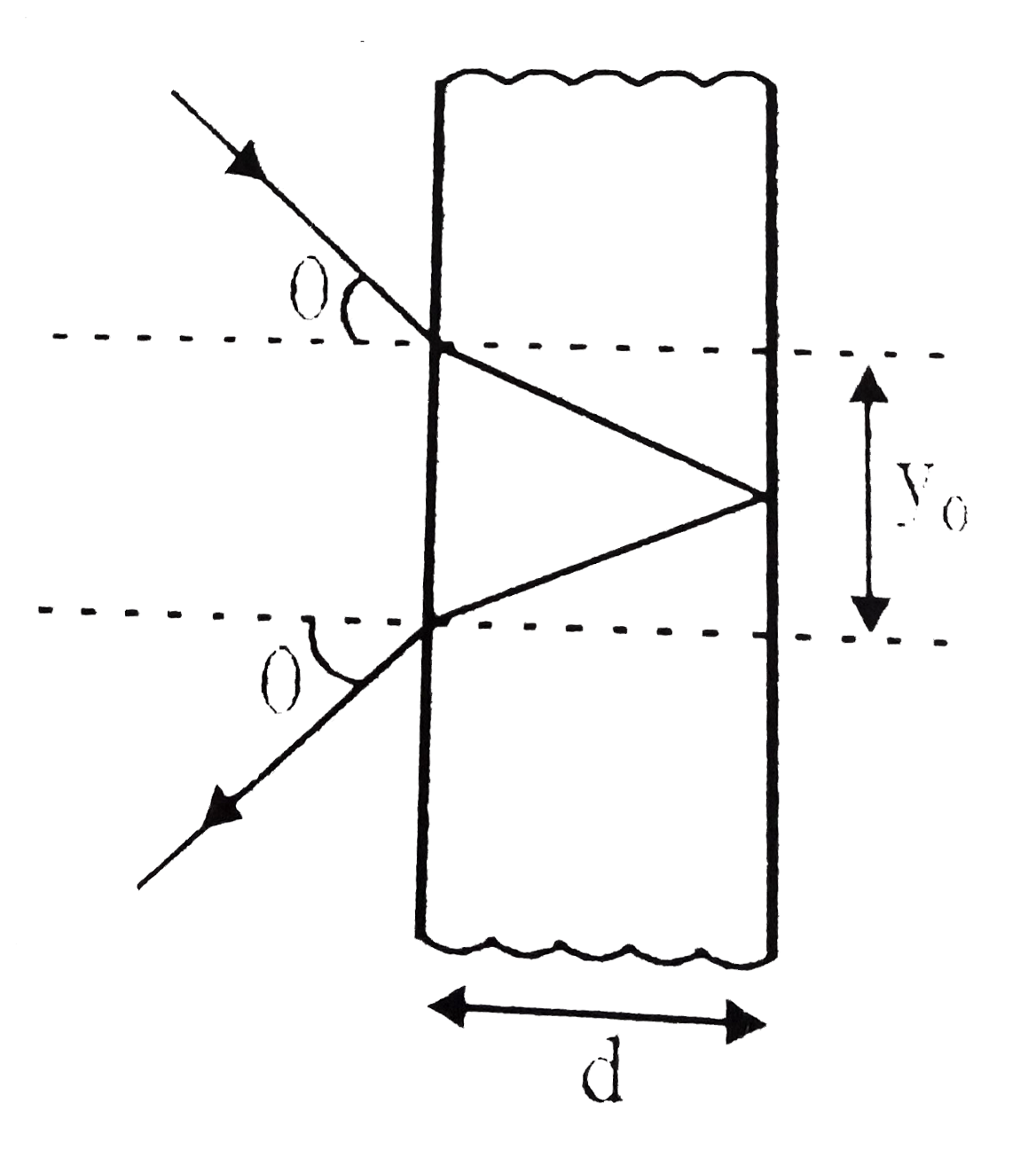A glass of refractive index 1.5 is coated with a thin layer of thickness t and refractive index 1.8 . Light of wavelength λ travelling in air is incident normally on the layer. It is partly reflected at the upper and the lower surfaces of the layer. It is partly reflected at the upper and the lower surfaces of the layer ant the two reflected rays interface . If λ=648nm, obtain the least value of t(in10−8m) which the rays interface constructively.
The correct Answer is:2μt=(n−12)λ with μ=1.8 and n=1,2,3..90,tmin=90nm
_E01_139_S01.png)
AB denotes incident ray. It is partly reflected from the upper surface of layer as R1.R1 is reflected from a denser medioum. It undergoes a phase change of π. Part of AB is relfected from surface of layer as R2.R2 is reflected from a rares medium
as .aμm=1.8 and .aμg=1.5
R1 and R2 therefore passess an initial phase difference of π before they undergo interference net phase ddifference should be 2nπ where n is an integer.
Δϕ=2nπ−π(2n−1)π∴x=(2n−1)λ2
since Δx=2(μm)t=1.8×2t=3.6t
or 3.6t=(2n−1)λ2
For least value of t is n=1∴3.6×tminλ2
or tmin=6483.6×2nm or tmin=90nm.
Topper's Solved these Questions
- WAVE OPTICSBOOK - ALLENCHAPTER - WAVE OPTICSEXERCISE - Exercise 2 (Previous Year Questions)
7 Videos
- WAVE OPTICSBOOK - ALLENCHAPTER - WAVE OPTICSEXERCISE - Exercise 5 A (Previous Years Questions)
17 Videos
- UNIT & DIMENSIONS, BASIC MATHS AND VECTOR BOOK - ALLENCHAPTER - UNIT & DIMENSIONS, BASIC MATHS AND VECTOR EXERCISE - Exercise (J-A)
7 Videos
Similar Questions
A convex lens of focal length 15 cm and a concave mirror of focal length 30 cm are kept with their optic axis PQ and RS parallel but separated in vertical directiion by 0.6 cm as shown . The distance between the lens and mirror is 30 cm . An upright object AB of height 1.2 cm is placed on the optic axis PQ of the lens at a distance of 20 cm from the lens . if A'B' is the image after refraction from the lens and the reflectiion from the mirror , find the distance of A'B' from the pole of the mirror and obtain its magnification . Also locate positions of A' and B' with respect to the optic axis RS.
_E01_247_Q01.png)
View SolutionThe outer surface of a transparent glass slab of refractive index μS=1.5 is coated by a thin layer of transparent medium of refractive index μC=1.6. Orange light of wavelength 6400Å falls normally on the coating. The reflected light at the upper surface and at the lower surface of teh coat interfere destructively. If thickness of the coat is 5K×10−8m, calculate the minimum value of K.
View Solution
Knowledge Check
A wave travelling in air falls on a glass plate . It is partly reflected and partly refracted. What is the phase difference between the reflected and refracted waves ?
A2πBπCπ2DzeroWhite light is incident normally on a glass plate (in air) of thickness 500nm and refractive index of 1.5. The wavelength (in nm) in the visible region (400nm−700nm) that is strongly reflected by the plate is:
A450B600C400D500White light is incident normally on a glass plate (in air) of thickness 500nm and refractive index of 1.5. The wavelength (in nm) in the visible region (400nm−700nm) that is strongly reflected by the plate is:
A450B600C400D500
A ray of light incident from air on a glass plate of refractive index n is partly reflected and partly refracted at the two surfaces of the glass. The displacement y0 in the figure is

View SolutionACB is right-angled glass prism of refractive index 1.5 . ∠A ∠B and ∠C are 60∘ 30∘ and 90∘ respectively.A thin layer of liquid is on the AB. For a ray of light which is incident normally on AC to be totally reflected at AB the refractive index of the liquid on AB should be
View SolutionA ray incident at a point at an angle of incidence of 60∘ enters a glass sphere with refractive index √3 and it is reflected and refracted at the farther surface of the sphere. The angle between the reflected and refracted rays at this surface is:
View SolutionA ray of light incident from air on a glass plate of refractive index n is partly reflected and partly refracted at the two surfaces of the glass. The displacement y0 in the figure is

View SolutionPolarising angle for water is 53∘. If light is incident at polarising angle on the surface of water and is partly reflected, the angle of refraction will be
View Solution